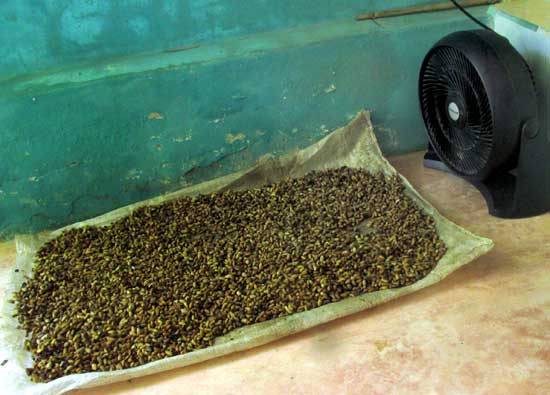Excerpts from Jim Conrad's
Naturalist Newsletter
from the January 19, 2009 Newsletter issued from near Telchac Pueblo, Yucatán, MÉXICO
NEEM
Neem is a tree native to India, and it's one of the earliest-recorded and most widely used of all medicinal plants. In Indian villages today Neem trees, AZADIRACHTA INDICA, are still thought of as "the village pharmacy" and are used for everything from bad teeth and bedbugs to ulcers and malaria.
Recent Western studies report that Neem extracts delay blood coagulation and calm erratic heartbeats; oral doses of Neem-leaf extract reduce insulin needs 30%- 50% for nonkeytonic, insulin-fast and insulin- sensitive diabetes; Neem extracts are toxic to the herpes virus and can aid in the rapid healing of cold sores; Neem has antihistamine properties; Neem extracts reduce fertility in male monkeys; Neem extracts have been approved by the US EPA for use on food crops and it protects crops from over 200 of the most costly pests. And there's a lot more. If you're interested in Neem, look it up with your search engine.
Maybe 15 years ago someone planted a lot of Neem trees where I am now. You can see a typical tree, now in the early dry season yellowing and losing its leaves and looking Septembery to a North American, below:

A close-up showing one of Neem's twice-compound leaves and blackening fruits, which are drupes, is below:
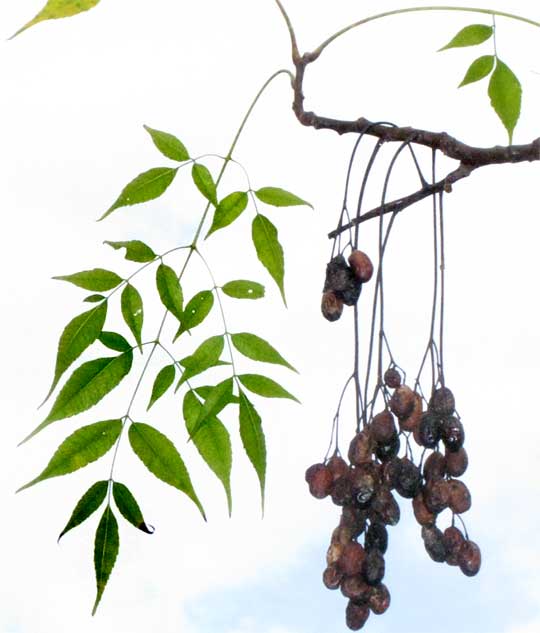
If you're in the US Southeast you may think that Neem looks a lot like Chinaberry, Melia azedarach, also originally from southwestern Asia, and which has gone wild there, in places becoming an important invasive species. There is indeed a similarity, for the species are closely related, both belonging to the Mahogany Family, the Meliaceae. Hunters in Mississippi have told me that if you rub Chinaberry leaves on your skin it'll repel mosquitoes, but I've found the leaves only mildly repellent.
By the way, if you're unsure what a "twice compound" leaf is, the one in the above picture is a classic example of one. All the connected green items at the picture's left constitute a single leaf. It's a compound leaf. If you look closely you'll see that first the whole leaf is divided into eleven units branching off the main stem, or rachis. In the picture the lowermost five units are undivided leaflets, but the upper six units are divided yet again into subleaflets -- they're "twice divided," "2-pinnate," or "bipinnate."
from the October 23, 2016 Newsletter issued from Rancho Regensis north of Valladolid, Yucatán, MÉXICO;
elevation ~40m (~130 ft), N~20.876°, W~88.170°
NEEM LEAVES FOR FUNGAL INFECTIONS
Here at the rancho many Neem trees have been planted and during upcoming months probably I'll report on several uses we make of them. This week both one of the burros and Chichan Cho' the black, hairless, edible dog turned up with fungus-infected feet. Neem is known to be especially good for treating the fungal-based athlete's foot, so for the feet of the burro and Chinchan Cho' we made Neem leaf paste. Gonzalo, the rancho's Maya manager, set about grinding some Neem leaves the traditional Maya way, with a carved, wooden pestle in a stone mortar, as shown below:
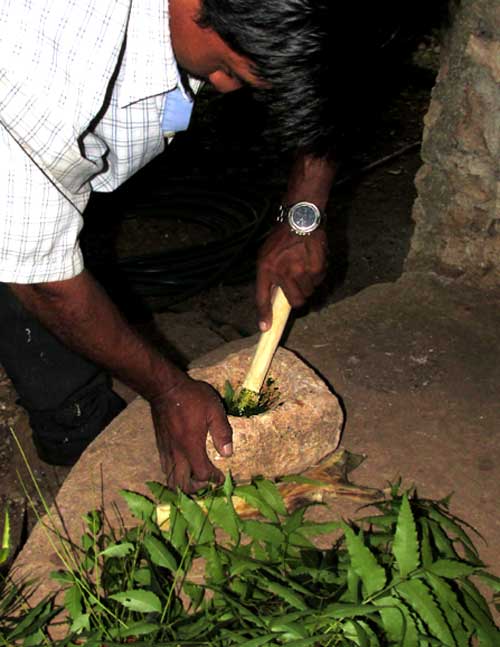
That produced a nice, green paste, which was applied to the burro's hoof bottom, and between Chinchan Cho''s toes. Neat cloth boots were sewn around the feet.
In the end, the burro's hoof remained infected so a veterinarian was called, who administered regular medicine. Chinchan Cho' always managed to chew and pull off his boot so that the green paste immediately fell away. I experimented with grinding leaves in our hand-turned "sausage grinder," which made a finer, moister paste, to which I added mucilage from aloe leaves. This made a clay-like paste that hardened a bit when it dried. However, Chinchan Cho' continued to chew off his boot and what paste didn't fall away, he chewed and licked off. It's no surprise that his foot didn't get better.
However, I managed to get the beginnings of a fungal infection on my own feet, since I go barefooted on the patio where the dogs hang out. When I applied the paste with aloe juice to my own feet and did not chew and lick it away, my own problem disappeared in a couple of days.
from the July 9, 2017 Newsletter issued from Rancho Regensis north of Valladolid, Yucatán, MÉXICO;
elevation ~40m (~130 ft), N~20.876°, W~88.170°
COLLECTING NEEM SEEDS
Here at the rancho one goal is to extract oil from Neem seeds. That explains what's shown below:
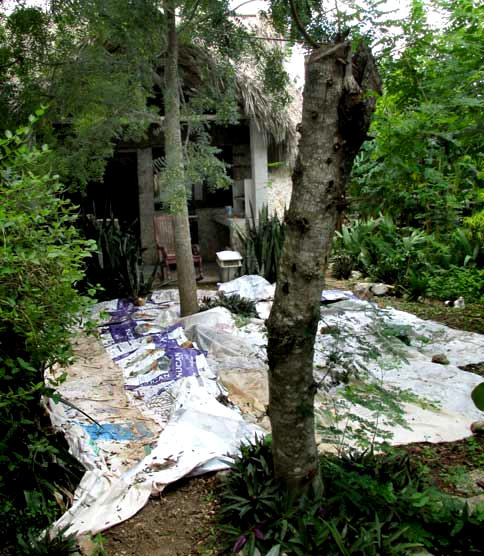
There you see a plastic sheet constructed of split-open animal-food sacks sewed together and spread beneath a fruiting Neem tree beside the hut in which I stayed when I first arrived. The homemade sheet makes it easier to collect the fallen fruits. Below, you can see a cluster of fruits on a low-hanging branch:
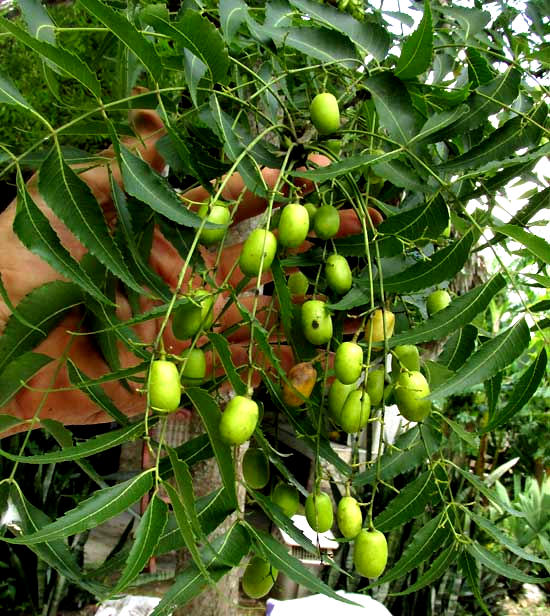
Each pea-sized fruit consists mostly of a large seed. Below, you can see a smashed fruit with its detached seed:
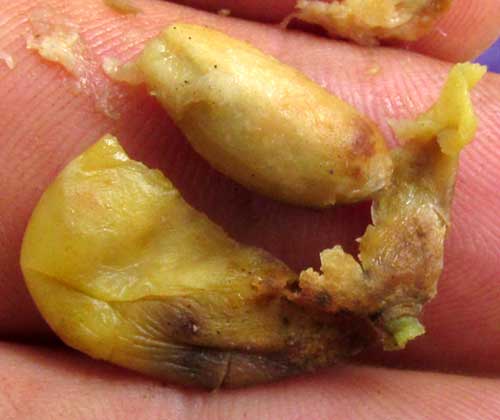
A handful of seeds dried on an elevated frame covered with screen wire is shown below:
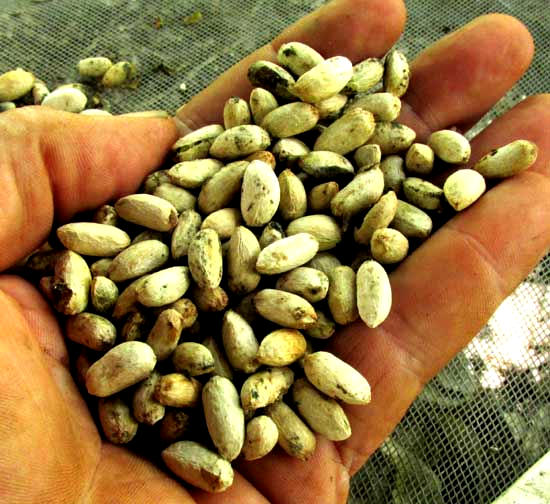
A seed broken across its middle is shown below:
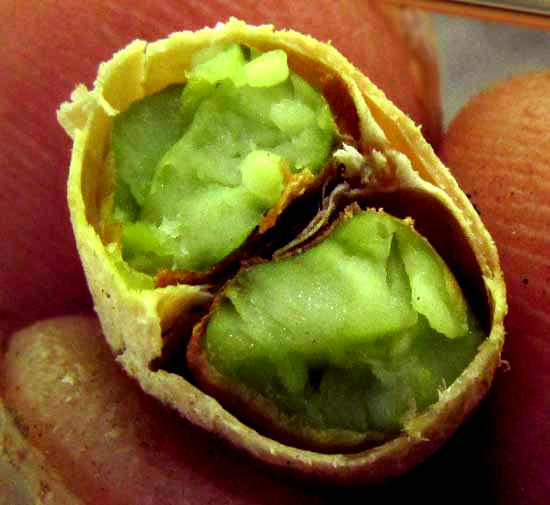
The two green items aren't two future plants, but rather the future seedling's first two leaves, its cotyledons. Inside the seed, the two cotyledons are joined at their bases, where the embryo resides.
In the above picture, if you look closely at the cotyledons' green broken surfaces you can see minute glistenings. These are tiny oil droplets. The idea now becomes removing that oil from the seeds and collecting it in a more or less pure state, for our own use. With luck, that process will be the subject of a later Newsletter entry.
from the July 23, 2017 Newsletter issued from Rancho Regensis north of Valladolid, Yucatán, MÉXICO;
elevation ~40m (~130 ft), N~20.876°, W~88.170°
CLEANING NEEM SEEDS
When Neem fruits drop and dry out, their skin and thin layer of pulp dry into a leathery, almost woody covering, that's hard to remove. At first we picked off the covering of each fruit with our fingers, but that was so slow and time consuming that it wasn't worth it. I experimented with several approaches and decided that -- at least on our small scale -- it was best to collect the fruits every few days, before the skin and pulp dried out. Last year they'd waited until most of the fruits had fallen, and collected them all at once, by which time the seeds were encased in their dried-out covering.
Collecting them every few days provides some fruits that have just fallen, some that have lain for a few days, and some that may have begun drying out, depending on the weather. A harvest of fruits in various stages of drying out can be poured into a container holding water. The fruits float and easily can be gathered between one's hands and rubbed briskly, so that seeds squirt from their coverings, or at least part of the coverings come off. Maya ladies hired to "wash the seeds" in this manner have plenty of practice with such hand motion, preparing masa for tortillas, and do a good job. Our ladies decided it was best to use a three-bucket approach, with the help of a strainer. Below, you can see what that looked like:
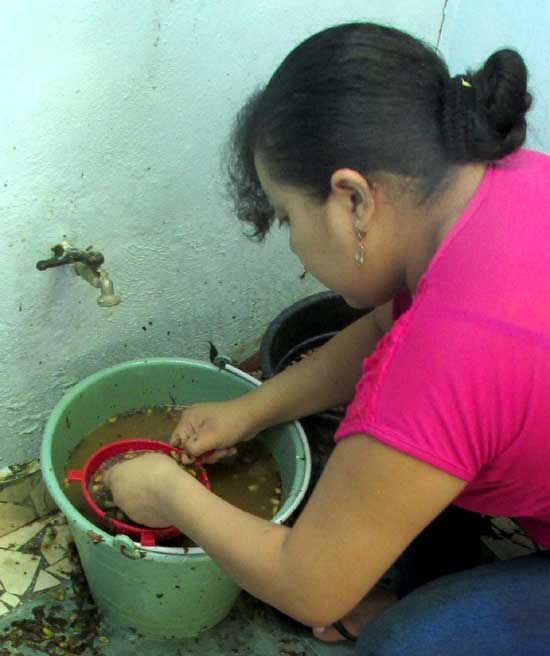
Each time the floating mass of skin, pulp and seeds was transferred to the next bucket, as much skin and pulp was removed as possible and thrown away, leaving seeds floating. Another shot of the process is shown below:
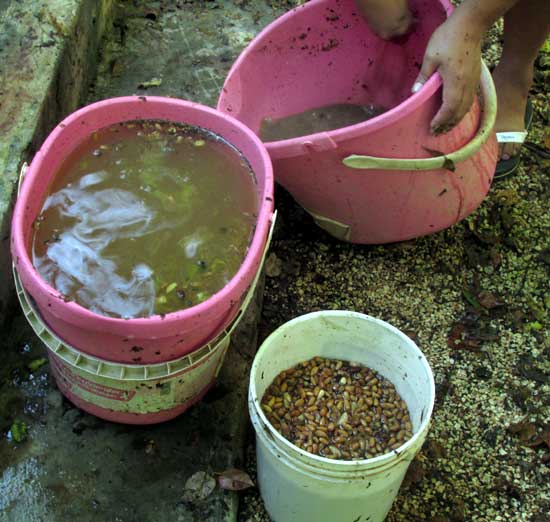
Once the seeds are washed and cleaned, they need to be dried out. Though Neem products are said to be anti-fungal, we've found that if the leaves and seeds remain moist long they get fungusy. Below, you can see Neem seeds being dried by fan:
